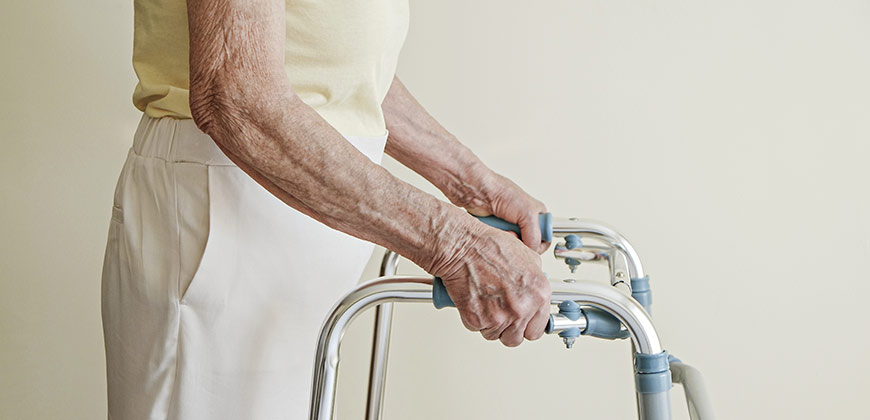Although there is no cure for motor neurone disease (MND) yet, research has shown some interventions can help people with MND to live better for longer.
The way that people manage their earlier symptoms of MND can affect how later symptoms can be managed. Early discussion about symptom management helps people with MND to plan ahead.
Below are lots of ideas to help with:
- Easing pain and discomfort
- Keeping mobile
- Managing fatigue
- Sleeping better
- Breathing easier
- Managing swallowing problems
Easing pain and discomfort
Pain and discomfort can be treated using a number of physical measures. These treatments are best accessed with the help of a physiotherapist.
Ways to ease pain and discomfort:
- Electrically operated beds and chairs and special cushioning can assist the person with MND improve their mobility and comfort
- Special cushions and mattresses can provide extra ‘padding’ and pressure relief, especially if the person has lost weight.
- Gentle passive exercise of those limbs which are too weak to be moved by the person’s own efforts can prevent pain arising from stiff shoulders and other joints
- Warm packs and baths are often useful, but care needs to be taken with temperature control
- The GP, neurologist or palliative care specialist can prescribe a range of medications for pain
- Relaxation therapy can be of great value especially if breathing or swallowing problems are also being experienced. It is possible that someone from the health or palliative care team may be able to teach a few simple relaxation techniques. Some people find commercially available relaxation tapes helpful. Others may find acupuncture useful in the treatment of pain.
Keeping mobile
Most people with MND develop mobility problems to a greater or lesser extent.
It is unlikely that people living with MND will stay in bed for long periods, but they may need help moving around. Some people have a tendency to fall, sometimes without warning.
Occupational therapists and physiotherapists can advise about access around the home and assist in the provision of appropriate aids to improve mobility and safety.

Managing fatigue
Fatigue is common in MND. By recognising the factors that worsen symptoms and by learning how to conserve energy, people with MND can improve their quality of life.
Some strategies for managing fatigue are:
- Plan activities in advance
- Take regular rest periods
- Rest between activities and before going out
- Do not exercise to the point of excessive fatigue, cramps, or muscular weakness
- Discuss with a physiotherapist exercises to alleviate stiffness, muscular tension, or pain
- Move slowly, with frequent rests, taking a few breaths before recommencing a task
- Keep heavier tasks for times of greater energy
- Stop if breathlessness occurs
- Discuss, with an occupational therapist, aids and equipment that can make tasks easier
- Take shortcuts where possible and sit rather than stand
- Try to establish a regular sleeping pattern
- Make the personal environment safe and easy to move around
- A sleep study may be useful when people with MND wake up regularly during the night and don’t feel refreshed by sleep
Sleeping better
Sleeping difficulties may be caused by a variety of reasons:
- Discomfort because of immobility
- Pain due to stiffness of joints or muscles
- Excessive saliva or dry mouth
- Breathing problems
- Emotional distress of receiving a diagnosis of MND or the stress of living with MND. In these circumstances the person with MND should be encouraged to speak with their neurologist or GP about counselling, ongoing support and medications to relieve anxiety or depression, if present.
People with MND may find it useful to have regular respiratory assessments, including sleep studies. These are most useful at a relatively early stage and their timing depends upon the level of abnormality detected. It may also be helpful to consider non-invasive respiratory support to improve sleep and day time exhaustion or sleepiness.
Different sleep strategies work for different people:
- If possible, try not to remain in the same position in bed for too long
- Satin or silk sheets may help moving about in bed
- An electric bed can be adjusted to a variety of positions at the push of a button
- Side rails, bedside furniture and extra pillows can give added support
- A segmented overlay mattress and specialised pillows distribute body pressure more evenly
- Muscle spasticity or pain from muscle tightness and joint stiffness may be relieved with medication prescribed by the GP
- Non-prescription analgesics such as aspirin or paracetamol can relieve mild discomfort
- Before retiring, joint pain may be relieved by stretching or range-of-motion exercises – a physiotherapist may be able to find the origin of the problem and recommend a remedy
- Breathing may be helped by elevating the head and chest with an extra pillow or two, or raising the head of the bed on blocks; this relieves pressure on the diaphragm and improves lung expansion
- Before going to bed, avoid over-exertion, caffeinated drinks, smoking and heavy meals – too much food puts pressure on the diaphragm and can aggravate breathing problems
- Retire at the same time each night and reduce daytime napping
- Make sure the bedroom is quiet, cool, dark and comfortable – light bedclothes allow easier movement in bed
- Impaired swallowing reflexes may cause a build up of saliva or mucus – sleep with the head elevated to prevent secretions from pooling in the upper airway
- A slow rhythmic back rub or a light massage of aching muscles promotes relaxation
- Deep abdominal breathing may reduce stress
- Soft music or reassuring conversation can promote sleep
Breathing easier
Many people with MND have decreased lung capacity because of muscle weakness, making any activity that requires increased respiratory effort harder.
Respiratory weakness can develop at any stage of disease progression and may cause shortness of breath, frequent waking during the night, fatigue, impaired quality of life and sleepiness.
Referral to a specialist respiratory physician should take place soon after diagnosis. A baseline measurement of breathing function can be helpful for future treatment.
Some people may also find their cough is less forceful than before, making it more difficult to clear their throat.
People with MND may experience the feeling of not being able to get enough air, rather like the sensation of being in an overcrowded room.
Tips for breathing easier:
- Position is important. Sitting in a slumped position restricts lung capacity. Sitting up may be better than lying down.
- When sitting, the bottom should be well back in the chair, the back straight and well supported.
- If excessive saliva or mucus is a problem, seek the advice of the GP and speech pathologist about controlling it. A physiotherapist can also teach assisted cough techniques.
- Avoid contact with people who have colds or flu and consult the GP about the need for a flu vaccination.
- Try to keep the bedroom and living areas at a comfortable, steady temperature (around 18 and 21 degrees respectively). Keep the rooms well ventilated and avoid smoking or being in the presence of smokers.
- Shortness of breath may be helped by breathing in a calm and purposeful way until the sensation has passed.
- Routine chest physiotherapy can be beneficial, but should not be too vigorous. The physiotherapist may also suggest a program of breathing exercises to help maintain lung expansion.
- If shortness of breath cannot be managed, the GP or neurologist should be consulted immediately.
- Medications can be prescribed to relieve feelings of breathlessness.
- Referral to respiratory specialist for reassessment and discussion about non-invasive ventilation.
Non-invasive ventilation (NIV)
NIV is delivered via a mask usually at night initially and then as required during the day as MND progresses. If the symptoms related to increasing respiratory muscle weakness impact on quality of life some people will choose to use NIV. This involves being referred to a respiratory specialist for assessment and regular review. The respiratory specialist will prescribe the appropriate machine to use and the settings required.
NIV has been shown to improve quality of life for people living with MND. NIV is suitable for many people with MND but it will not be suitable for everyone. There are a number of implications to consider that should be discussed with the specialists involved. Over time NIV will be less effective in controlling respiratory symptoms.
Managing swallowing problems
Some people with MND experience swallowing difficulties which require adaptation of the process of eating and drinking. Referral to a speech pathologist and a dietitian should occur as soon as any swallowing or saliva difficulties are experienced.
People experiencing swallowing difficulties can be more prone to chest infections.
The following suggestions might be useful:
- Modify the texture and consistency of food and drink
- Puréed (vitamised or blended) foods that are smooth, moist and free from lumps, but not runny, are usually easier to swallow
- Purée different foods separately and serve attractively, providing a contrast of colours and flavours at each meal
- Thickened drinks flow more slowly and are thus easier to control
- Try a lightweight cup with a wide, flared top
- It is usually easier to eat from shallow spoons
Lorem ipsum dolor sit amet, consectetur adipiscing elit. Donec dapibus quis metus sed fringilla.
- Small amounts of food and drink per swallow reduce the risk of inhalation - in most cases drinks should be sipped
- Reduce the size of each mouthful until the person with MND finds what is best for them – some people find that teaspoon-sized mouthfuls are easier to manage
- Allow more time to eat and drink; do not try to keep pace with others during meals
- Eat and drink in private if desired
- People with MND should eat foods that they like – taste is a strong stimulus for the swallow reflex
- Swallowing is generally easier when the person is sitting as straight as possible with the head upright; avoid tilting the head back or bending it forward towards the chest; some people find swallowing easier if the head is slightly forward, as if sniffing the air
- More specialised eating utensils, such as spouted cups and syringes are also available – a speech pathologist or occupational therapist can provide advice
- The presence of ropey, tenacious secretions in the mouth and pharynx can make swallowing more difficult – drinking fruit juices, particularly grape juice, and sucking papaya enzyme tablets can help to break down the secretions.
Gastrostomy (PEG and RIG)
If swallowing becomes too tiring, or too difficult, the person may choose to have a gastrostomy. This entails having a tube surgically inserted through the upper abdominal wall into the stomach under a light anaesthetic.
There are two types of gastrostomy available depending on the surgical method used – a percutaineous endoscopic gastrostomy (PEG) and a radiologically inserted gastrostomy (RIG). Food, usually a proprietary liquid feed, is put into the tube (known as PEG or RIG feeding).
Having a gastrostomy does not necessarily mean that the person with MND cannot eat. Often, a small amount of food for pleasure can be consumed while most of the nutritional intake occurs via the gastrostomy. This approach may reduce fatigue and should be considered by those who experience marked problems in eating or drinking.
